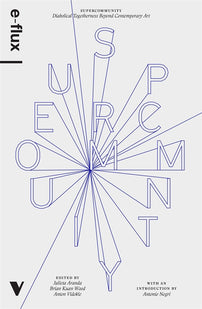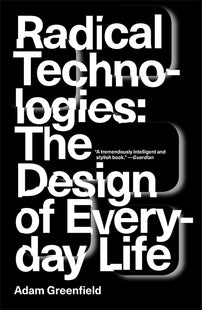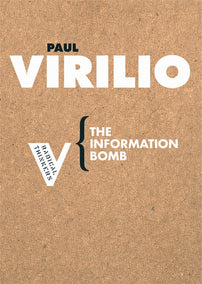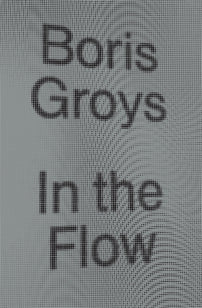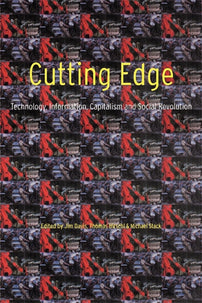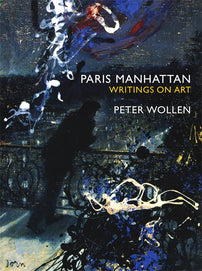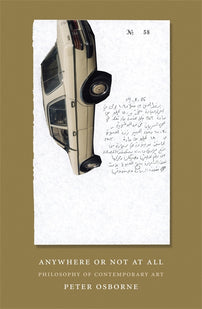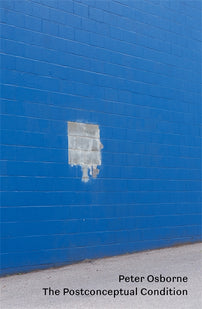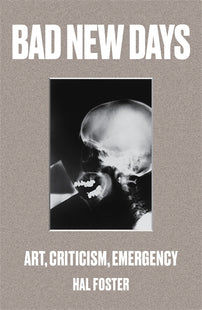Digital Debris
In this excerpt from Duty Free Art, Hito Steyerl on spam; a substantial expression of a period that has elevated superfluity into one of its guiding principles.

This essay — first published in October — is collected in Duty Free Art: Art in the Age of Planetary Civil War, out now from Verso and on sale for 50% off until January 1.
There is hardly a more famous watercolor painting than Paul Klee’s work Angelus Novus. Walter Benjamin described the figure on it as a hapless creature, helplessly carried away by the storm of progress, while staring backwards at a rubble heap growing sky high in its wake. 1 Benjamin’s aphorism is well known and quite overquoted. But it has a surprising and overlooked consequence, if we take its spatial arrangement seriously.
There is no rubble depicted on the drawing whatsoever. But this doesn’t mean there is no rubble at all. Since the angel faces us as spectators, and — according to Benjamin — also faces the rubble, the wreckage must be located in the hors-champ of the drawing. This means that the rubble is where we are. Or, to take it one step further: we, the spectators, might actually be the rubble. We might be the debris of history, those who somehow made it through the twentieth century, but not unscathed. We have become discarded objects and useless commodities caught in the gaze of a shell-shocked angel who drags us along as it is blown away into incertitude.
However, the debris caught in the angel’s stare might take on a different form today. Are rubble and wreckage not outdated notions for an age in which information is supposed to be copied without loss and infinitely retrievable and restorable? What could refuse look like in a digital age that prides itself on the indestructibility and seamless reproducibility of its products? When information presumably has become immortal and immune to the passing of time? Aren’t the scars of history signs of an analog age, one which is irrevocably over? Hasn’t history itself worn itself out and gradually disintegrated?
Actually, the contrary is the case: history is not over. Its wreckage keeps on piling sky high. Moreover, digital technologies provide additional possibilities for the creative wrecking and degradation of almost anything. They multiply options for destruction, corruption, and debasement. They are great new tools for producing, cloning, and copying historical debris. As they get amplified by political and social violence, digital technologies become not only midwifes of history, but also its (plastic) surgeons.
Despite its apparently immaterial nature, digital wreckage remains firmly anchored within material reality. Among its contemporary manifestations are toxic recycling cities like Guiyu in China, where mainboards and hard disks are being scavenged and the ground water is poisoned. But in the digital age, debris is not only composed of destroyed buildings, torn concrete and decaying steel, even though digitalized warfare, the computerization of production, and real estate speculation produce these items in abundance. Digital wreckage is both material and immaterial, data-based debris with a very tangible physical component to it.
There is hardly any better example of such digital debris than spam. 2 Far from being the exception in online communication, spam is actually the rule. Around 80 percent of all email messages have been spam in recent years. Spam forms the bulk of digital writing, its essence. And it too has a firm grasp on reality. It is an active and extensive substance. Far from being secondary and accidental, this form of digital debris is a substantial expression of a period that has elevated superfluity into one of its guiding principles.
To complete Benjamin’s spatial equation: if the angel looks at us, we must be rubble. And if rubble means spam at present, this is the name that the angel bestows on us today.
You Shall Be Spam
Pharmacy 81% Replica 5.40% Enhancers 2.30% Phishing 2.30% Degrees 1.30% Casino 1% Weight Loss 0.40% Other 6.30% 3
The contemporary use of the term spam for unwanted electronic bulk communication takes its cue from its appearance in a Monty Python’s Flying Circus sketch from 1970. It is set in a café, where two customers ask for the breakfast menu:
(Scene: A café. All the customers are Vikings. Mr and Mrs Bun enter—downwards, on wires.)
MR BUN. Morning.
WAITRESS. Morning.
MR BUN. What have you got, then?
WAITRESS. Well, there’s egg and bacon; egg, sausage and bacon; egg and spam; egg, bacon and spam; egg, bacon, sausage and spam; spam, bacon, sausage and spam; spam, egg, spam, spam, bacon and spam; spam, spam, spam, egg and spam, spam spam spam spam spam spam, baked beans, spam spam spam and spam; or lobster thermidor aux crevettes with a mornay sauce garnished with truffle pâté, brandy and a fried egg on top and spam.
MRS BUN. Have you got anything without spam in it?
WAITRESS. Well, there’s spam, egg, sausage and spam. That’s not got much spam in it.
MRS BUN. (Shrieks.) I don’t want any spam! [...]
MR BUN. Don’t make a fuss dear. I’ll have your spam. I love it. I’m having spam, spam, spam, spam, spam ...
VIKINGS. (Singing.) Spam, spam, spam, spam ...
MR BUN. ... baked beans, spam, spam and spam.
WAITRESS: Baked beans are off. 4
Monty Python’s sketch is the story of a conquest: spam — the canned food — slowly but decisively invades every item on the menu as well as the whole dialogue, until there is nothing left but spam, spam, and spam. This process is celebrated by a band of Vikings and other incongruous participants. Spam inundates the plot and even the final credits at the end of the show. It’s a triumph by repetition and as cheerful as it is overwhelming.
In the sketch spam initially refers to the canned meat of the same name. But then this meaning is twisted around to emphasize verbal reiteration and the uncontrolled replication of the term itself. This second meaning came to be amplified in the realm of newly emergent online practices.
In the 1980s, the term spam was literally used as a type of invasion within MUD (multi-user dungeon) environments: people would type the word repeatedly so as to scroll other people’s text off screens. Content didn’t matter; bulk did. The word spam turned into an inert material, capable of physically blocking out unwanted information.
Sending an irritating, large, meaningless block of text in this way was called spamming. This was used as a tactic by insiders of a group that wanted to drive newcomers out of the room so the usual conversation could continue. It was also used to prevent members of rival groups from chatting ... for instance, Star Wars fans often invaded Star Trek chat rooms, filling the space with blocks of text until the Star Trek fans left. This act, previously called flooding or trashing, came to be known as spamming. 5
Spamming thus emerged as an online activity bent on displacing somebody or something else by using verbal repetition. Words were actually used as extensive objects, which had the potential to spatially push away other words. Nowadays, spam has become more of a commercial calculus. Bulk email messages with commercial or fraudulent intent are flooding data connections worldwide and causing quite substantial economic damage by wasting time and effort. 6 Even though the ratio of customers acquired through this process is extremely small it’s still a viable business. Needless to say that effortless technological reproduction forms the economic framework of this venture. Spamming is the pointless repetition of something worthless and annoying, over and over again, to extract a tiny spark of value lying dormant within inert audiences.
Artificial Meat
But what other conclusions can we draw apart from these very obvious observations? What else does spam as a chunk of contemporary digital rubble tell us about the present? Let’s have a closer look.
Before spam became a word that turned into an object, it was an object already. And this object is the item initially celebrated by the Monty Python number: the famous brand of canned meat produced by Hormel Foods Corporation. Its dubious composition has earned it many nicknames, ranging from “Specially Processed American Meats” to “Supply Pressed American Meat,” “Something Posing As Meat,” “Stuff, Pork and Ham,” and “Spare Parts Animal Meat.” Its elements look extremely suspicious; its essence is ersatz. Its cheapness is also why it was included in many dishes in the postwar period, perhaps too many as Monty Python’s sketch seems to suggest. Spam was and still is a cheap lower class and army food staple. It presents an uncanny mix between the natural and synthetic. It is both organic and deeply inauthentic, an industrial product with some remnants of nature in it. Meat that has been grinded so rigorously that is has possibly leaped into another type of existence: as a deeply phony and suspicious substance yet nutritious enough to enable military invasions and sheer subsistence.
But precisely its composite nature makes spam an inter- esting term to consider in political theory, especially within the discussion of biopolitics. For Toni Negri and Michael Hardt flesh is a metaphor for a body not inhibited by social or any other restrictions. They euphorically describe flesh as “pure potentiality” oriented toward “fullness,” inhabited by angels and demons, as well as bristling with a new barbarian counterpower. 7 Flesh is seen as an incarnation of vitality and additionally imbued with religious and even messianic discourse about redemption and liberation. 8 It is a post-Nietzschean repository of pure positivity.
In contrast to this heroic description of living flesh, spam is just humble hybrid meat. It lacks all of the pompous attributes of flesh. It is modest and cheap, made of bits and pieces, which may be somewhat recycled and are staunchly inanimate. It is meat as commodity, and a really affordable one too. But this doesn’t mean that it should be underestimated either. Because spam addresses the hybridized commodity aspect of forms of existence, which run across humans and machines, subjects and objects alike. It refers to objectified lives as well as to biological objects. As such it may speak much more of actual conditions of contemporary existence than purely biological terms.
Spam has been through the meatgrinder of industrial production. This is why its fabrication resonates with the equally industrial (or postindustrial) generation of populations worldwide, who endured the mincer of repeated primordial accumulation. Several cycles of debt bondage, subsequent exodus, draft into industrial labor and repeated rejection from it force people back into subsistence farming, only to see them reemerge from tiny fields as post-Fordist service workers. Like their electronic spam message counterpart, these crowds form the vast majority of their kind but are considered superfluous, annoying, and redundant. They are also assumed to replicate uncontrollably. These populations are spam, not flesh; made of a material that has been ground for generations by a never-ending onslaught of capital and repackaged in ever new, increasingly hybrid and object-like forms.
Electronic spam highlights the speculative dimension of these bodies. It is painstakingly obvious that most products marketed via e-spam are supposed to enhance bodily appearance, performance, and/or health. Email spam is a format that attempts to act on bodies: by cashing in on role models of uniformly drugged, enhanced, super-slim, super-active, and super-horny people wearing replica watches to always be on time for their service jobs. 9 More than 65 percent of email spam tries to push anti-depressants and Viagra, or rather rip-off pills boasting the same effects, thus selling fantasies of perfectly exploitable bodies, coveted production tools for superfluous crowds. Both forms of spam are post-carnal: they deal with the production of enhanced, altered, artificial, processed, upgraded as well as degraded forms of flesh.
But spam is not without its own counterpower. In Ed Ruscha’s admirable 1962 painting Actual Size a resplendent spam can is caught flying in a downwards trajectory. A glowing trail makes it look like a crossover between a comet and a Molotov cocktail. Spam is a solid object equally airborne and combustible as well as potentially imbued with kinetic power. Spam cans can be hurled into bank windows. They are sturdy and resilient.
In some cases, culinary applications of spam also manage to overturn its relations with warfare and deprivation. One example is the Hawaiian use of spam as delicacy. Spam became popular after Japanese were banned from fishing during World War II. Thus “Spam became an important source of protein for locals.” 10 But far from remaining a hallmark of scarcity, it was redeployed as an ingredient in inventive dishes like Spamakopita, Spam Musubi, Spam Katsu, Spam loco moco, Spam fusion fajitas, Spam somen, Spam chutney, Spam Mahi Carbonara and Spamaroni and cheese. Similar interpretations of spam exist in Korea, where it spread after being imported by the US military. The German version is called Döner Kebab; 11 an extremely popular form of orientalist roast spam impaled on supersized skewers. This dish was invented by downsized Turkish migrant workers in the 1970s. Since then it has become Germany’s unofficial national dish. These uses of spam highlight the composition of the constituency of its consumers and (sometimes) improve its appeal to the senses.
But even electronic spam has unexpected affinities to social composition. Indeed, it was initially explicitly defined as a res publica, a public thing. One of the first spam filters developed was based on the quite unlikely finding that any email containing the word republic would almost invariably end up being spam. (The other dubious keywords interestingly being “madam” and “guarantee”). 12
Spam — in its different versions — is thus resolutely public. It is always made from several sources, things and bodies, letters, metals, colors and proteins alike. Its element is commonality; a mix of components animate and inanimate, as impure as one could possibly imagine.
Spam transforms words into carnal objects, as in Ruscha’s painting. This incarnation goes way beyond its religious precedents, though. Let’s face it: the incarnation of words today mostly takes the form of spam, spam, and spam.
History
But spam is not only a passive substance, endowed with the power of blocking and crowding. It also brings about very different forms of social organization. It changes the ways in which a group of people is structured and organized in interaction. In Monty Python’s sketch, spam becomes a pivotal term which is pointing at a change not only in the paradigm of labor, but perhaps also in the form of history itself.
An insert at the very end of the sketch shows a history teacher sitting in a classroom and detailing the invasions of Vikings:
HISTORIAN: Another great Viking victory was at the Green Midget café in Bromley. Once again the Viking strategy was the same. They sailed from these fiords here (indicating map with arrows on it), assembled at Trondheim and waited for the strong north-easterly winds to blow their oaken galleys to England whence they sailed on May 23rd. Once in Bromley they assembled at the Green Midget café and spam selecting a spam particular spam item from the spam menu would spam, spam, spam, spam, spam ...
(The backdrop behind him rises to reveal the café again. The Vikings start singing again and the historian conducts them.) 13
This tiny scene looks quite unassuming. But in fact it shows how the representation of history itself is being transformed by the invasion of spam. Initially, the historian starts giving an authoritative classroom-style frontal account of events from a slightly elevated position, complete with map-style overviews.
But as spam starts flooding the dialogue, the wall behind the historian is revealed to be a stage curtain as it is lifted, and the initial café setting reappears behind it.
The historian produces a conductor’s baton and joins in the wild celebratory spam chorus. First he appears to direct this cacophony, but then seems to give up on it and breaks the baton in two.
Two different modes of address are presented in this short insert: first, the historian addresses spectators as a class inside a classroom. After the change of scenery the frontal address is abandoned, as our point of view is transformed into a mixture of a customer’s and an audience perspective. While the first mode of address presents a slightly authoritarian educational model, the second is clearly adjusted to a situation of service as performance or performance as service. This shift is catalyzed by the renewed invasion of spam into the dialogue. Spam pushes out a mode of addressing a class and introduces a mode of address based on service and spectacle, sustained by customers suspended in mid-air.
The form of the temporality inherent in the scene shifts as well: whereas there is a clear narrative of invasion and progress before the transition, afterwards there is just the pure spectacle of incongruous, unsynchronized, profoundly multi-cultural, salacious, and free-floating performative services. A joint celebration, which has no conductor, leader or avant-garde, but emerges spontaneously and in common.
Spam’s takeover transforms a pseudo-scientific account of history (and its “progress”) into a performative chaos in which actors, consumers, spam, and service workers become indistinguishable. The linear and teleological progression of history, complete with its narration by academic administrators, is discontinued. The unity created by the frontal address of class is gone. The mood shifts from education to celebration.
But the public composition of spam is not only about fun and merriment. It also clearly penetrates the framework of the production of spectacle, as the final credits, which start rolling immediately after this scene demonstrate. Spam infiltrates job titles and the names of producers and technicians. Exclamations from the service sector are interspersed (not Sundays/spam’s off, dear). It’s not as if spam erased labor, it just erases class by penetrating and invading labor and laborers alike.
Spam is thus given as the description of both labor and its performers. It is an activity, a subject and an object alike, as well as an uncontrollably multiplying word that describes all of the former. People are being included into the world of spam and turned into potentially edible matter. Words are incarnated as objects and vice versa. And the only slogan that rallies the chaotic spam and service work/workers left is given in the final titles of the sketch.
Conceived, written and spam performed by
SPAM TERRY JONES
MICHAEL SPAM PALIN
JOHN SPAM JPHNSPAM JOHN SPAM CLEESE
GRAHAM SPAM SPAM SPAM CHAPMAN
...
Film Cameraman
JAMES (SPAM SAUSAGE EGG AND TOMATO) BALFOUR (NOT SUNDAYS)
...
Film Editor
RAY (FRIED SLICE AND GOLDEN THREE DELICIOUS) MILLICHOPE (SPAM EXTRA)
...
BBC SPAM TV
Service not included
Service Not Included
This slogan is the inherent promise of spam. While Hardt and Negri rave about the angelic potential of flesh and its relentless release of desire, the promise of spam is much more prosaic: Service not included means simply it should not be for free. Even in the digital age, service cannot be reproduced indefinitely. But at present the line “service not included” is not a description but a claim that waits to be realized. In the world of service as performance (and performance as service), labor is abundantly available for free, as if it too could be copy-pasted and duplicated digitally.
Of course little of this issue is reflected in the piles of repetitive spam matter which clogs mail accounts and data lines worldwide. But why not see its material excess as an anticipation of a time when the spam incarnated in service and spectacle workers, as well as in everybody else considered superfluous and dispensable, starts to speak and utters the slogan: service not included?
Contemporary electronic spam tries to extract an improbable spark of value from an inattentive crowd by means of inundation. But to become spam — that is, to fully identify with its unrealized promise — means to spark an improbable element of commonality between different forms of existence, to become a public thing, a cheerful incarnation of databased wreckage.
There is one question left to explore: how does Monty Python’s spam sketch actualize a different form of history? At first glance the question might have been answered by the transformed behavior of the historian, who gives up his vantage point of authority to wholeheartedly participate in the creation of chaos. But there is another aspect, too.
Let’s hark back to Paul Klee’s watercolor. There is another mystery in this painting: the angel just slightly averts its gaze, it doesn’t really look at us.
Is it perhaps distracted by something happening behind it? Could it have been caught at the very moment when the uniform background behind it starts moving upwards, revealing itself as a stage curtain? Is it about to turn around to join in with a new scene instead of being torn between mourning past demise and a violently displaced future? And what will it order from the breakfast menu?
Notes
1. Walter Benjamin, “Theses on the Philosophy of History,” in Illuminations: Essays and Reflections, ed. Hannah Arendt (New York: Schocken Books, 1968), 257–8.
2. Thanks to Imri Kahn for drawing my attention to this subject. A very helpful text on spam is Finn Brunton, “Roar so Wildly: Spam, Technology and Language,” Radical Philosophy 164 (November/December 2010), 2–8.
3. Commtouch Online Security Center, commtouch.com.
4. The Broadview Anthology of British Literature, Concise Edition, Volume B, ed. Joseph Black et al. (London: Broadview Press, 2015), 1509–10.
5. Myshele Goldberg, “The origins of spam,” MysheleGoldberg.com, May 21, 2004: “When the Star Wars fans got tired of intelligent debate or angry arguments, they went back to their ‘spam and tang’ logic. ‘Whatever,’ they would write, ‘Star Trek is just about spam and tang.’ Spam and tang Spam and tang Spam and tang Spam and tang Spam and tang Spam and tang Spam and tang Spam and tang Spam and tang Spam and tang Spam and tang Spam and tang Spam and tang Spam and tang Spam and tang. They would copy the same message dozens, hundreds of times, filling up every line in the chatroom so nobody else could type.”
6. One of the most interesting examples in this context was the sale of an edition of Andy Warhol’s non-existent work Spam in an online auction at us.ebid.net (accessed in June 2011).
7. Michael Hardt and Antonio Negri, “Globalisation and Democracy,” in Reflections on Empire, ed. Antonio Negri and Ed Emery (Cambridge: Polity, 2008), 79–113, 93, 94.
8. Antonio Negri, The Labor of Job: The Biblical Text as a Parable of Human Labor (Durham, NC: Duke University Press, 2009), 72.
9. Ellen Messmer, “Experts link flood of ‘Canadian Pharmacy’ spam to Russian botnet criminals,” Network World, July 16, 2009: “In this case, ‘Canadian Pharmacy,’ hyping itself as ‘the #1 Internet Online Drugstore,’ is neither Canadian nor a pharmacy. In fact, ‘Canadian Pharmacy’ doesn’t appear to exist as an established website but only as a shifting hyperlink in a spam message generated by about eight crime botnets.”
10. Michael F. Nenes “Cuisine of Hawaii,” in American Regional Cuisine, The Art Institutes SM (Hoboken: Wiley, 2007), 479.
11. In contrast to pan-Ottoman versions of the dish, the German rendition is generally made of preproduced spam cones. Eberhard Seidel-Pielen, Aufgespießt - Wie der Döner über die Deutschen kam (Rotbuch: Hamburg, 1996), 47f. Seidel-Pielen claims that the decline of Fordist production systems in German car industries forced many industrial migrant workers to become small entrepreneurs and open snack bars, thus paving the way for Germany’s only important culinary innovation in the twentieth century. Döner Kebab is made from many official and unofficial components including cookies, sperm, dog food, salmonella. He also recounts how young German Neo-Nazis would come running to the Döner stand while arsoning migrant workers’ hostels during early ’90s post-unification pogroms, showing the Hitler salute with one hand and clutching their Döner with the other. See Alan Posener, “Auch Deutschland dreht sich um den Döner,” Welt Online, May 30, 2005.
12. Brunton, “Roar so Wildly,” p. 4.
13. Broadview Anthology of British Literature, Concise Edition, Volume B, 1510.
[book-strip index="1" style="display"]

